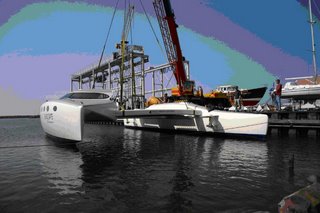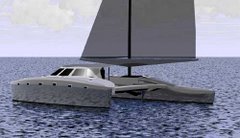"First Light", our Visonarry proa is underway.
A partial set of plans we're printed yesterday for what will become "First Light", a 60' Rob Denney designed Visionarry proa. Some materials are in house. The path has been an interesting one and has brought about some fairly radical changes in the life of my wife Julie and I. I'll sum it up by saying that when we decided to build a boat less than a year ago we were living in 'no weather' Santa Barabra on a postage stamp piece of dirt and I write this sitting on a chair in Perry, Maine (or shall I say Maine-ada) overlooking the Bay of Fundy which is currently spun into a frenzy by 45 knot wind. The decision was made so we had room to build the proa. The tail has wagged the dog. We'll save this story for another day.
I've decided to blog this out since others who have done the same when building a boat describe it as therapeutic, motivational and a means to keep a healthy perspective.
There will be quite a bit of 'thinking out loud' here to go with the build process. I'll ramble on about 'Why a proa' and 'Why a Visionnary design' later. For now we'll keep it to the boat instead of our personal adventure.
Here's what were looking at today in terms of build materials and process.
Hulls: E-glass and epoxy over strip planked red western cedar using male molds.
Bulkheads: Vacuum bagged E-glass and Epoxy over end grain balsa
Beams: Vacuum bagged carbon and epoxy over strip planked red western cedar
Foils: Carbon and Epoxy
The decision was made to stay away from the closed cell foams for several reasons. Cost being one. The other being that the by-products of the foam manufacturing process are super-toxic. I have no delusions that the build will be 'less-than-green' but we've decided to draw the line at foams manufactured with methylene chloride.
The shell materials (except carbon) will be purchased from Composites One.
Still working out the details as to the final rig configuration. However, at this point we are leaning towards a twin cat rig with freestanding rotating masts. Chord will be set as a balance between performance and 'fully reefed windage'. Having a sail plan which allows full control of sail-shape is important. Most of the proa rig configurations I've researched do not allow for adequate control of the sails shape. The thought of a sloppy leech or a saggy headstay is not tolerable. We may go with a wishbone set up. Still researching this. There are a few projets underway using this configuration. Hopefully their efforts will be useful in determining our final rig down the road.
Regarding outfitting: The last two cruising cats I've sailed have been outfitted to the the point of silliness. The Norseman / Mayotte 47 had twin diesels, watermaker, three televisions (one a 35" flat panel), A/C, icemaker, three heads, two computers, refrigerator, freezer and a Martha Stewart equipped galley.
I won't even go into what was on the Gunboat. Wow..
Our goal is to keep things a bit more simple, less expensive and enjoy the more traditional aspects of cruising versus a 7.1 surround sound DVD entertainment center. Hopefully we'll be cruising with the Mayotte and Gunboat guys and can barge in on movie and frozen margarita night. We start the rudders tomorrow..
And so it begins......


